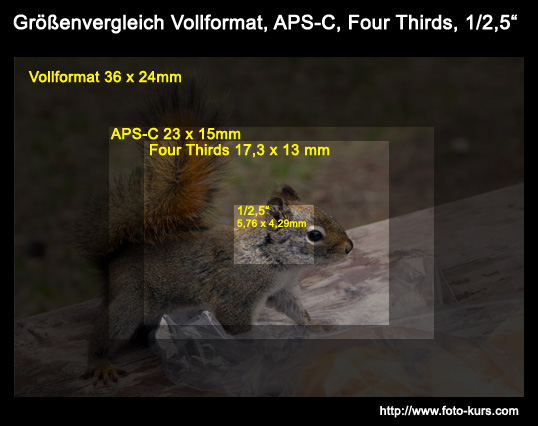
Basic functions of a digital camera:
The image sensor of a digital camera
The image sensor translates the incoming light into a digital image. For this it saves several single image points - also called pixel. The word pixel is a coinage and is comprised by the word element and pictures - colloquial "pix" - "Pi(x)cture Element". The amount of pixel delievers the resolution. So, if the pictures has horizontally 5616 pixel and vertically 3744 pixel, there there are 5616 * 3744 = 21.026.304 pixel - in common terms the resolution is 21 mega-pixel. Truth is, you need 4 pixel to capture and safe the color informations.
Size-comparison of image sensors of digital cameras
Simple and concise: why bigger image sensors are better (and which disadvantages they have). The bigger the size of an image sensors the more light can enter the camera and fall onto the available space. The quality differences can easily be seen when taking photos with less light. On the one hand because bigger image sensors produce significant less image noise (signal-to-noise ratio). On the other hand, a certain size of image sensor is needed to shape photos with elements of sharpness and blurriness.
Advantages of big image sensors:
- higher quality (fewer image noise)
- more creative playground (Sharpness - Blurriness)
Disadvantages are:
- bigger image sensors are more expensive
- a qualitative higher objective is needed (more expensive, weighs more) and
- the camera housing is bigger and heavier.
The crucial determinant is, how much quality you want, how much weight you accept (and how much money you want to spend).
The traditional measures and terms of the analogue photo techniques were transferend into the digital photography. The common 35mm film with a format of 24 x 36 mm is the measurement of all things. Viz. it is exactly the size of the full-frame sensor. The focal length also relates with this 35mm film format, even if the own camera doesn/´t even have a full-format sensor (then a little bit of calculating is necessary).
Here a list of the differenz sizes of image sensors of digital cameras and their description:
| Name | Size | Aspect ratio |
|---|---|---|
| Full-frame sensor | 36 x 24mm | 3:2 |
| APS-C | 23 x 15mm | 3:2 |
| Four Thirds 4/3 | 17,3 x 13mm | 4:3 |
| 1/1,7" | 7,6 x 5,7mm | 4:3 |
| 1/1,8" | 7,18 x 5,32mm | 4:3 |
| 1/2,5" | 5,76 x 4,29mm | 4:3 |
Size-comparison of different image sensors of digital cameras
Following a size-comparison of different image sensors of digital cameras directly compared in a picture.

The size of an image sensor is specified by the "format factor" or crop factor. The common english term crop factor is more precise. There are some common values with the crop factor: „1,4“, „1,5“, „1,6“, „1,7“ and sometimes even „2“.
The crop factor tells us, with which number the focal length (compare chapter "objectives and digital cameras") has to be multiplied.